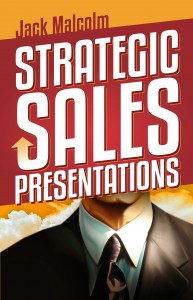 As should be obvious to my readers by now, I’ve recently been on a kick to apply lean principles to sales and personal productivity. The core of lean is to reduce muda, or waste, and waste is defined as any activity that does not add value to the customer.
As should be obvious to my readers by now, I’ve recently been on a kick to apply lean principles to sales and personal productivity. The core of lean is to reduce muda, or waste, and waste is defined as any activity that does not add value to the customer.
If you work in sales for a company, you probably have to enter an account plan into a CRM system, and you are very likely less than enthusiastic about it. Companies love CRM systems because it helps them capture information about their customers, but one of the major challenges is to get salespeople to consistently supply accurate information.
Why is that? There are actually three customers for the activities that salespeople perform: their customers, their employers, and themselves. In many cases, the only one of those three who receives value from many CRM systems is the employer.
Salespeople naturally would rather spend their time in front of customers than in front of computer screens filling out forms, so they’re naturally reluctant to take the time. In addition, they often see the systems as a surveillance tool that their management uses to keep tabs on their activities.
Customers don’t care if the account plan gets into the seller’s CRM, because to them that is not an activity that adds value. In fact, if they can’t reach the account manager because he or she is busy filling out their forms, they see it as worse than waste.
Fortunately there is a way out of this. The trick is to design the plan so that it adds value to all three stakeholders. A properly designed account plan does more than capture static information about a customer. It allows for the salesperson to think critically and plan for ways to deliver insights, consulting, or solutions[1] to help their customers improve their business.
Salespeople will get value from the plan if it helps them focus their thinking on what they know and don’t know about their customers’ needs and decision process. Probably the major benefit that participants in my account planning workshops get is uncovering the “unknown unknowns”, those hidden land mines that often turn out to be the difference-makers in winning or losing business. Most salespeople are way overconfident about how much information they carry in their heads. They think that they know everything they need to know about the customer’s situation, and the only way to expose the fallacy is to force them to write down the answers to hard questions. When they uncover what they know and don’t know about the customer’s needs, the solution fit and the decision process, their action steps become much clearer to them, which leads to less wasted activity and shorter selling cycles. Well-designed account plans also share information within the various members of the sales team and help spark additional ideas.
How does the customer benefit from well-designed account plans? When salespeople are sincerely using plans to figure out better ways to provide value, solve problems, or help the customer achieve their business and personal goals, they will bring better solutions. They will also waste less of the customers’ time.
In fact, if the employer designs the account plans from the point of view of helping salespeople better add value to the end customer, their own value will take care of itself, because salespeople will embrace the process and consistently provide accurate and valuable information.
Actually, you could apply this approach to any sales activity. Simply ask yourself how much value each customer of the activity is getting from it. Those that help the end customer and the salesperson, usually end up benefiting the employer as well.
[1] I’m covering my bases with the Challenger Selling and Solution Selling camps here. Just call me Switzerland.
 I will be perfectly open about the ulterior purpose of this blog post: I’m cheating a little bit so that I can maintain my streak of writing a blog post every work day.
I will be perfectly open about the ulterior purpose of this blog post: I’m cheating a little bit so that I can maintain my streak of writing a blog post every work day.
In the interests of strengthening my writing habit and to pump up my presence in social media, I last month resolved to make a big leap from 1-2 blog posts a week to 5, or one every work day. So far, this is my 23rd in a row—but it has not come easy.
The common wisdom is that it takes seven days to make a habit permanent. I’ve never found this to be true for myself. To me, the two most crucial times for a habit are the first day and the fourth week. The first day is critical because you have to start some time. How many times have you procrastinated on starting something you really wanted to do, to the point that you never got started at all? Once I start, initial enthusiasm easily carries me through the first seven days and beyond.
If that enthusiasm can carry you all the way to the point where your new activity is solidly entrenched as a habit, you’ve got it made. But old ways die hard, and enthusiasm may run out before habit kicks in. Sometimes you have to find a way to straddle that gap, and that’s where cheating comes in. By cheating, I mean doing the minimum that technically meets your goal. Let’s say you’ve decided to exercise every day, but maybe you’re under the weather and don’t feel like dragging yourself to the gym: why not do a set of push-ups or sit-ups at home? It will only take a minute or two, and it’s only a small fraction of a full workout, but it’s an infinite multiple of nothing.
Sometimes, you might even find that the little bit you do is enough to overcome inertia and then you keep going. That’s actually what has happened with this post. I thought of the topic this morning only after this sequence of steps:
- I have no idea what to write about today.
- I go through my list of ideas that I’ve stored, but find all kinds of reasons against each one.
- I think it may not be so bad to miss a day; maybe it was a dumb idea anyway.
- I remember that I use the cheating trick with my workouts, and try to decide how I can apply it here.
- I’m not quite sure how this ties in to persuasive communication, sales, or clear thinking, but I figure it’s close enough.
- I begin this article, hoping I can get out a paragraph or two.
- Once I get this far, I’m actually starting to get into it, so I start digging a little further…
Charles Duhigg, in his excellent book The Power of Habit: Why We Do What We Do in Life and Business, explains that habits are created by a “habit loop” of cue-routine-reward. The cure is the trigger that fires the routine. It may be the running shoes at the foot of your bed, or the pack of cigarettes on the counter. As silly as it may sound, the empty check box at the top of my daily to-do list is my cue, and it works. The routine is the hard part, of course, especially when the reward is not something tangible. I find the feeling of accomplishment to be reward enough, and that apparently is extremely common. 67% of people who exercise regularly cite that feeling as their primary reward.
I wrote previously about personal kaizen, and it’s great to constantly improve a little every day. But some days it’s victory enough not to regress, even if you have to cheat a little to win. Of course, I’m not advocating cheating every time, because all that will instill is a habit of mediocrity. But keep in mind that you can’t win the game unless you’re in it.
 Tens of thousands of sales presentations are delivered to potential customers every day, but very few of them are strategic sales presentations.
Tens of thousands of sales presentations are delivered to potential customers every day, but very few of them are strategic sales presentations.
A sales presentation is strategic when it delivers the right content to the right people at the right time to advance or close your sale.
Right content: The majority of sales presentations are really talking brochures, in which the salesperson verbally delivers content that is easily available to audience members on web pages or in promotional material. It usually talks about the features of the product or touts the virtues of the company selling it. Right content is about the customer: how their business outcomes can be improved through their decision to buy your offering. How will their current processes be improved, what problems will be solved, and what will be the financial impact of these changes? One simple test is to look at your content and calculate the percentage that talks about your customer versus about yourself and your solution. In addition, calculate how much of the content is specific to that one customer at that particular time. You can take this even further by ensuring that content is targeted to the needs and concerns of specific individuals.
Right people: Very early in the sales cycle, you may need an executive to be present to ensure the project receives the priority it deserves, and of course you want them there for the closing presentation. But be careful of imposing on their time when you’re not directly adding value to them. In the evaluation stage of the customer’s buying process, their presence may be unnecessary and even counterproductive.
It’s also a natural tendency to want to pack the audience with your supporters and avoid detractors or opponents. If you have identified opponents in the decision process, it is crucial to have them there when you present, even if it adds another level of stress. This will at least give you a chance to answer their objections. If you exclude them, they will just voice their objections when you’re not there. Or, if they feel the decision was forced on them, you’re going to have a tough time during implementation even if you do make the sale.
Right time: You have to understand where your customer is in their buying cycle and tailor your content accordingly. If they haven’t fully recognized their need, for example, it would be premature to focus on the superiority of your solution.
There’s a saying that nothing is as powerful as an idea whose time has come, which implies that the idea will fall flat if the time is not right. If what you are selling is a radical departure from status quo or challenges long-held beliefs and attitudes, it’s unlikely that you will succeed in one shot. In such cases, the quiet behind-the-scenes selling and lobbying you do will shape the conditions for success.
Advance the sale: A sales presentation is still a sales call, and one of the most fundamental—and ignored—steps in sales calls is to specify up front your purpose for the call. The call purpose must be viewed within the context of the sales opportunity plan, and thus must include a measurable advance in the sales cycle. It does not have to be a close; in long complex sales cycles closing calls are in the minority. But it should add value to the seller and the buyer. (In fact, you could profit from changing the wording to “advance the buying decision in your favor”.)
For example, a purpose could be to “gain agreement on the cost of the problem”. This purpose adds value to the seller by increasing the buyer’s urgency to make a decision and potentially shortening the sales cycle. The buyer benefits by recognizing the scope of the problem and possibly by gaining insights that will help them improve the potential solution.
To ensure that your sales presentation is strategic, then, use this short checklist:
Do I have the right content that targets your listeners’ unique needs and concerns?
Are the right people in the room?
Is this the right time for this presentation?
Am I crystal clear on what I want to achieve and why?
“Don’t look for the big, quick improvement. Seek the small improvement one day at a time. That’s the only way it happens—and when it happens, it lasts.” John Wooden
Years ago, my kids and my wife got into the beanie baby craze. These were small teddy bears that came in hundreds of varieties. Each cost only a few dollars, so from my point of view it was a great gift. The problem is that they were so cheap that my wife thought nothing of buying one—no single purchase was painful. But over the months the purchases continued; by the time I started looking into it, we figured out that they had spent over $800 in teddy bears!
The beanie baby incident was a reminder of how small things can add up very quickly, and great transformations can happen through tiny changes patiently accumulated. That’s the central idea behind kaizen, the strategy of continuous improvement that is one of the core principles of lean thinking. It works as well in personal productivity as it does on the factory floor.
Kaizen works mathematically not only because things add up, but because of the magic of compounding. A small percentage improvement continuously applied over time means that each successive improvement is larger than the last, and that can make a huge difference over time.
But kaizen also works because of the psychological mechanism. While we’re often exhorted to set big goals for ourselves, the size of the goals can sometimes be self-defeating. Big goals can stress us out; they engage our mind’s self-defense mechanism and engender fear. How many times have you set yourself a big goal—say, a new year’s resolution—and had it fail? Kaizen can help melt resistance.
Besides improving ongoing efforts, kaizen can help you get started on things that you’ve been putting off. One reason we procrastinate on large goals is that their very difficulty can generate fear. We know it will take a large effort, so we put it off until we think we can be in a position to succeed. But often that time never comes. It’s better to take some small steps today that move us a tiny bit closer, than never to take the big steps that will get us a lot closer. There’s a wonderful quote from a mindfulness coach in One Small Step Can Change Your Life: The Kaizen Way, by Robert Maurer: “I’d rather they go home and meditate for one minute than not meditate for thirty minutes.”
Kaizen isn’t just a practice—it’s also a mindset. It’s having the attitude that your performance is not limited by fixed abilities and traits but rather is under your control. It’s about creative dissatisfaction: knowing that it is always possible to improve a process. Finally, it’s about being mindful of what you’re doing and why that opens your eyes to improvement possibilities.
Here are some small steps you can begin taking now to start implementing kaizen:
Choose an area to apply it. Kaizen can be applied to specific areas of your personal life and work, such as fitness, relationships, or learning a particular topic. It may also be applied to the way you work, such as implementing some of the ideas in this series. For example, you can make small improvements in the length of dedicated focused time you spend on a project. 5S is also a great area for applying kaizen. Although it’s a great idea to start with a blitz to begin sorting, setting in order, etc., you may not be able to get to it all at once. So, take a little time each day or each week to chip away at some areas.
Every day a little up. The header of this paragraph is a nice little phrase from The Remedy: Bringing Lean Thinking Out of the Factory to Transform the Entire Organization by Pascal Dennis. The key word in continuous improvement is continuous. You can’t develop habits in quick bursts—they must come from the patient accumulation of actions and small successes. But those small successes can become large over time. Continuous means that kaizen is not something separate from your daily work that you do once in a while when you have time or you think of it, but it becomes a part of your work. You become mindful of what you are doing and how you are doing it and improvement opportunities are more likely to become visible. That’s why it’s a good idea to have a journal or other consistent place where you can record ideas as they occur to you. You can also build in time during your morning plan or your evening’s review to remind yourself.
Set your goals lower. If you don’t have the time right now for the big goal, break it down into smaller parts and choose those.
Big changes can be OK, too. Although so far the focus has been on small changes, there is definitely nothing wrong with big breakthrough or radical transformations if you happen to think of them and have the motivation to pursue them. In fact, you can combine the two approaches. Just as companies will have dedicated kaizen events, in which they will bring together people for three days to brainstorm improvement ideas, you may occasionally pick an area you would like to improve and then take some time to think about the processes and jot down ideas.
Copy and improve. A friend of mine likes to brag that he uses the CASE method: “Copy and steal extensively.” No one has a corner on good ideas, and we can always learn from what others are doing. But blind copying isn’t enough; what worked for them might work differently in our own situation, so we should try to improve their practices and ideas. The Japanese have a word for it: yokoten.
Just remember, even though perfection may be impossible, perfecting is something you can do every day.



